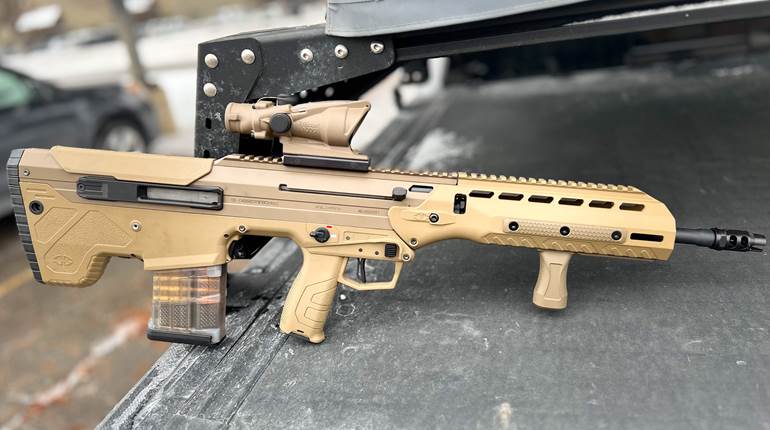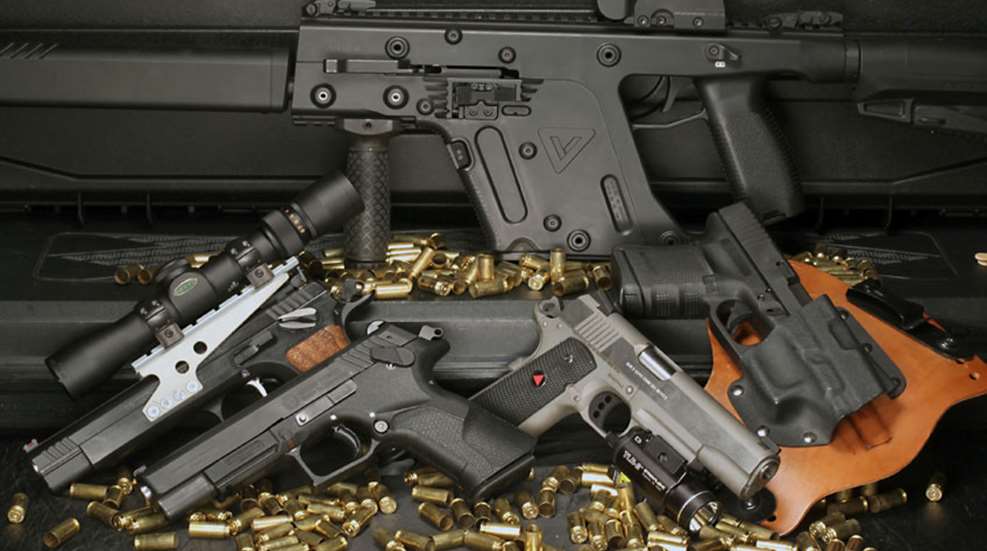
Anyone in search of a candidate for the title “Comeback Kid of the Cartridge World” should take a serious look at the 10 mm Auto. Though ballistically the 10 mm is known for its flat trajectory, its arc through history has seemed more like the peaks and troughs of a heart monitor readout. Touted as the “ultimate,” lampooned as a “dud,” ensnared in problems and mired in controversy not of its own making, no other cartridge in the modern era has teetered on the brink of obscurity and clawed its way back as many times as this proverbial cat.
Along the way, the 10 mm Auto has acquired its own mythology, including a healthy dose of downright falsehood: the power of a .41 Magnum; a destroyer of firearms; a recoil monster waiting to gobble up weak and timid shooters. The 10 mm is not really any of these things. Those who have taken the time to get to know the 10 mm have discovered what it really is—a powerful and versatile handgun cartridge that favors the performance-oriented aficionado of semi-automatics.
Lately, the 10 mm has experienced a renaissance of sorts that has resulted in its greatest popularity since it was introduced. To understand the 10 mm Auto’s new-found success I took a look at some contemporary 10 mm firearms. But to understand how the 10 mm got to where it is today, I also needed to understand its history. So, first, a little truth.
The History
The 10 mm Auto was born from an attempt to get maximum performance out of a 9 mm Luger-size handgun. Gun writers such as Jeff Cooper had been kicking around the idea of a .40-cal. cartridge that would offer more power than a 9 mm and more capacity than a .45 ACP. In the early 1970s, Guns & Ammo editor Whit Collins experimented with the concept using a Browning Hi Power. The result was the .40 G&A, a cartridge based on the .30 Remington case with the 180-gr., .40-cal. bullet from the old .38-40 Winchester launched at around 1000 f.p.s. Cooper envisioned an even-higher-performing “.40 Super” that would fit in a .45 ACP frame. At the time, he was particularly enamored with the then-new CZ 75, stating that the Czech pistol produced in a “serious caliber” would be “the great leap forward.”
From its origin in 1976, the Int’l Practical Shooting Confederation (IPSC) did much to advance both shooting techniques and handgun design. By the late 1970s, two IPSC competitors, Pachmyr gunsmith Tom Dornaus and police officer Michael Dixon, decided to join forces to develop the ultimate law enforcement and military service handgun. Though both were M1911 shooters, they felt that an entirely new handgun and cartridge design was necessary, a combination that would be “the heir to the Colt .45 Auto.”
Forming Dornaus & Dixon Enterprises, the pair sought to pull together the best elements of contemporary service handguns into one design, taking their inspiration from the M1911, the High Power, the SIG P210 and the CZ 75. When you’re trying to best the M1911, who better to consult than Mr. 1911 himself? Dornaus and Dixon approached Cooper through their IPSC connections, and he happily joined the project as a consultant.
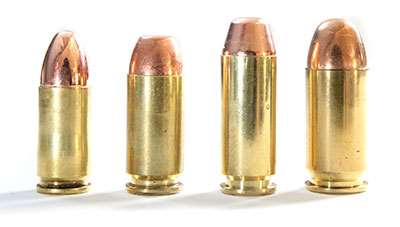
Dixon, who had a background in the aerospace industry, took the lead, designing the new pistol’s cartridge. The .45 ACP-size pistol they worked on had more room than Collins’ Hi Power. Using .41-cal. bullets swaged down by Sierra and cut-down rifle cartridge cases, a new cartridge was created. Sweden’s Norma would perform final testing and development on the cartridge. The initial Norma loading was a 200-gr., jacketed, truncated-cone bullet that achieved 1200 f.p.s. out of a 5" barrel. Though conceived in America, the new cartridge would eschew a caliber designation. Cooper insisted it be called the “10 mm,” a title that he felt had a modern ring to it. Dixon added “Auto” to the end, and the 10 mm Auto was born.
Cooper also gave the new pistol its name. The CZ 75, which had inspired much of the gun’s external form and internal mechanics, had been designed at the same CZ factory as the light machine gun that would become the ZB-26 and later the famous British Bren gun. So it was “Bren” for the pistol’s Czech influence and “Ten” for its metric diameter. Cooper reviewed an early Bren Ten prototype in 1982, noting that the 10 mm bullet retained more energy at 100 yds. than the .45 ACP had at the muzzle and stated “the trajectory of the 10 is quite a bit flatter than that of the 45, and its superior projectile mass retains its long-range power better than that of any minor-power cartridge.” The article ended with Cooper’s highest endorsement: “[T]he Bren Ten is a bright light on the horizon. It could be the dawn of a new era, and I do not say that carelessly.”
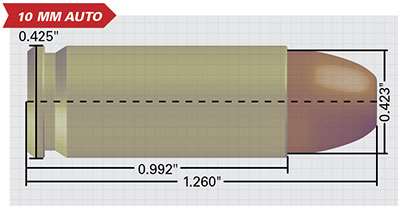
In 1984, Dornaus & Dixon introduced the Bren Ten to the market. It was a 10-shot, double-action/single-action that weighed 38 ozs. Early reviews were ecstatic about both the handgun and its new cartridge, with headlines such as “The Gun of the Future” and “Powerhouse.” The pistol was quickly snapped up by Hollywood, too, appearing in Sonny Crockett’s shoulder holster in the television series “Miami Vice.” With a standout, modern cartridge and an innovative, high-capacity handgun to chamber it—all endorsed by the godfather of American handgunning and featured on the most popular show on television—what could possibly go wrong?
In a word, everything. Dornaus & Dixon was attempting the impossible: to establish a brand-new firearm manufacturer that would use the latest technology to build a brand-new handgun design in a brand-new chambering. That’s not an easy task in the best of times, and the challenge was compounded by the lack of available capital in the stagnant economy of the early 1980s. Also, like any new design, the Bren Ten was not without its teething problems. Issues with overseas magazine production led to a delay in shipping out pistols. Quality control problems caused some pistols to be returned to the factory. Finally, under tremendous financial strain, Dornaus & Dixon was forced to close. About 1,500 Bren Tens were produced before manufacturing ceased in 1986. It seemed the newest “Most Likely To Succeed” cartridge had washed out while still a rookie.
With the demise of the Bren Ten, Dixon sought to make sure the 10 mm Auto cartridge wouldn’t fade into obscurity. He sent out the engineering drawings and sample cartridges to all major American ammunition manufacturers. The first resurrection of the 10 mm Auto was just over the horizon.
In 1984 Colt had considered licensing the Bren Ten in 9 mm Luger to be produced for the Army’s XM-9 pistol trials (it ended up submitting its own design, the SSP, to the competition). In preparation for a possible collaboration, representatives from Colt visited Dornaus & Dixon’s Huntington Beach facilities. A seed had been planted. One year after Dornaus & Dixon closed its doors, Colt released its iconic M1911 design in 10 mm, calling it the Delta Elite. By chambering America’s handgun in 10 mm Auto, the cartridge gained wider acceptance and jump-started domestic production of 10 mm ammunition.
The Delta Elite made limited inroads into the law enforcement community, but during an era in which the world of police sidearms was still dominated by the wheelgun, a single-stack, single-action semi-automatic made little headway. When law enforcement agencies did transition to semi-automatics, their firearm of choice was the latest double-stack “wonder nine.” For the following three years, the 10 mm Auto was once again spinning its wheels.
Enter 10 mm Auto Revival, Part II, courtesy of the Federal Bureau of Investigation. Incidents such as the 1986 Miami shootout had the FBI questioning the effectiveness of the .38 Spl. and 9 mm Luger handguns its agents carried. In 1987, it decided to extensively test the then-available semi-automatic pistols in 9 mm Luger and .45 ACP. The agent in charge of the testing, John C. Hall, decided to throw his personal handgun into the mix. That pistol was a Delta Elite.
In the resulting landmark study, which established the protocol for testing law enforcement ammunition, the FBI quickly took a shine to the flat-shooting, hard-hitting 10 mm, but as Hall noted in a 1989 FBI Law Enforcement Bulletin announcing the bureau’s adoption of the 10 mm, “The high chamber pressures generated by the commercial loadings, with the resultant heavy recoil and muzzle blast, tended to offset the otherwise excellent performance of the round.”
The FBI realized that a 10 mm Auto with about 25 percent less velocity would still give the performance it desired. So it decided to have the ammunition down-loaded to propel a 180-gr. bullet at 950 f.p.s. In 1989, it adopted the cartridge and put out a Request For Proposal for a pistol to chamber it. In January 1990, it was announced that the winning design came from Smith & Wesson. Adapting its large frame, double-action .45 ACP platform, Smith & Wesson produced the nine-shot, stainless steel Model 1076. The FBI would go on to order 12,000 of the pistols.
Law enforcement agencies around the country followed the FBI’s lead in adopting the 10 mm in a Smith & Wesson handgun. The cartridge took off in the civilian world, too. By late 1990, Auto-Ordnance, Colt, Smith & Wesson, Glock, Ruger and Springfield were all offering 10 mm pistols. “The 10 mm Auto is the greatest handgun success story of the last 50 years,” one gun magazine declared. But just when it was being lauded as the king of handgun cartridges, the 10 mm Auto hit road block number three.
Manufacturers had a mere 50 days from the release of the RFP to submit their design. The FBI was very specific as to its requirements, dictating features such as the reset of the trigger down to 1/16 of an inch. Another specification was that the pistol must be equipped with a frame-mounted decocker, a feature many agents had developed an appreciation for with their SIG Sauer P226 pistols. To meet these requirements, Smith & Wesson altered its traditional slide-mounted decocker to a SIG-style frame-mounted one. (Colt’s official entry for the FBI’s new handgun eventually evolved into its Double Eagle, a double-action M1911-style pistol that also featured a frame-mounted decocker). The changes altered Smith & Wesson’s time-proven double-action design, and, as a result, problems ensued. It was quickly discovered that sometimes a round in the magazine would contact the trigger drawbar and jam the 1076’s mechanism. In a hammer-fired gun this meant that the pistol was locked up tight. There were also problems with magazines, extractors and trigger springs. By May 1991, with less than 1,000 of the new pistols in the field, the FBI announced that it was recalling its 1076s. FBI Director William S. Sessions called the move “extraordinary, but necessary, until the weapon’s reliability can be determined.” The national press, through which the FBI had widely publicized its adoption of a new handgun, was merciless. “Red-Faced FBI’s New Superguns are Super Duds,” the headline of one major newspaper read. Many law enforcement agencies, which had followed the FBI’s lead, were also experiencing problems. Smith & Wesson scrambled to find solutions.
While their 10 mm Auto-chambered handguns were heading back to the factory, FBI agents were allowed to use bureau-approved 9 mm Luger handguns. When the updated 1076s were returned, many weren’t interested. The remainder of the 1076 order was cancelled, and Smith & Wesson’s production of all its 10-series handguns ended in 1993.
Instead of cementing the 10 mm’s place in the market, the FBI’s adoption of a down-loaded version of the cartridge would deal another blow. Smith & Wesson soon realized it could pack “10 mm Lite” (as the FBI loading was known) performance into a 3-mm shorter case that would fit into a 9 mm-sized frame. The .40 S&W, a cartridge very close to the concept that Whit Collins had experimented with nearly two decades earlier, was developed. It was introduced in 1990, just as law enforcement agencies were beginning to take interest in the 10 mm Auto. Offering the performance of the FBI load in a smaller package, the “Forty” quickly eclipsed the Ten and took the law enforcement market by storm. The 10 mm Auto once again found itself watching from the sidelines.
The late 1990s were the 10 mm Auto’s darkest days. Several proposed 10 mm handgun and rifle designs were shelved or became .40 S&Ws. Production of the Delta Elite ended in 1996. The FBI officially adopted the .40 S&W cartridge and the Glock handgun in 1997, though the S&W 1076 soldiered on with the few agents who preferred it. By 2000, only Glock and European American Armory (EAA) were offering 10 mm pistols. A few law enforcement agencies hung onto a 10 mm service pistol into the early 2000s, but the cartridge was kept alive by a hardcore fan base, who still believed the 10 mm was the ultimate, semi-automatic handgun cartridge.
By the time the Great Recession was getting started a strange thing happened. There was a waxing interest in the 10 mm Auto again—driven by a rising popularity of semi-automatic hunting handguns with electronic sights, pistol-caliber carbines and an interest in magnum-power self-protection. It seemed as if everything old about the 10 mm has been made new again.
Fourth time’s the charm, right? In each of the 10 mm Auto’s previous three ages there were never more than 20 different models of firearms chambered for it at any one time. Now, almost 50 manufacturers can boast more than 80 different firearms in the resurging cartridge, with new models seeming to appear about once a week. From out-of-vogue to flavor-of-the-week, the 10 mm Auto has found the firmest ground on which it’s ever stood.
To survey the 10 mm market these days, I took a look at five firearms that represent both the chambering’s history and its contemporary diversity. While the 10 mm Auto has been chambered in every type of firearm, from the single-shot Thompson/Center Contender to Smith & Wesson N-frame revolvers to custom lever-action rifles, it was designed as a cartridge for self-loading firearms. Within those parameters I tested the following semi-automatic 10 mms:
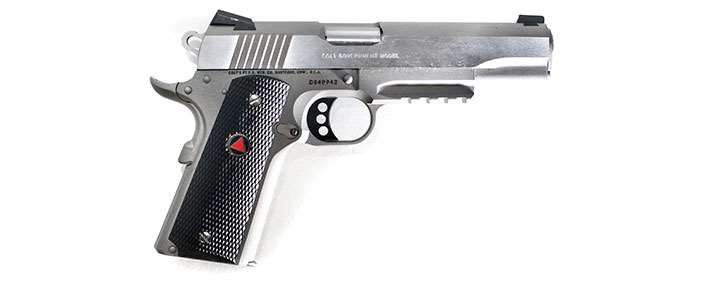
The M1911—Colt Delta Elite Rail Gun
In John Browning’s classic, the 10 mm Auto found the platform where it continues to thrive. The M1911 outlasted the Bren Ten that was intended to replace it, and its adoption of the Bren Ten’s cartridge has kept the chambering alive. The all-American M1911 remains the most popular type of 10 mm firearm, with almost every M1911 manufacturer offering the chambering as an option.
An M1911-based 10 mm is the ideal way to move into the cartridge for those who are already invested in the platform. The external dimensions of 10 mm M1911s are virtually identical to those of their .45 ACP grandparents, so holsters, magazine pouches and stocks are usually interchangeable. Also, non-cartridge-specific parts, such as triggers, hammers and grip safeties, are usually the same as well, meaning an extensive aftermarket supply is available to 10 mm Auto M1911 shooters who can set up their 10s just like their favorite .45s. An M1911 is also the most affordable way to get into the 10 mm Auto, with some of the base models selling for around $400.
Colt re-introduced the Delta Elite in 2009. The original Delta Elite kept a standard “government” profile, and the new pistol followed suit. In 2016, Colt upgraded the Delta line with Novak sights, beavertail safety, enhanced hammer and trigger, flat mainspring housing, lowered ejection port and flared magazine well. For the purist, there’s still the triangular “delta” logo on the stocks. Inside, it’s your basic Series 80 Colt 1911, with the exception of the dual recoil spring and buffer system used to handle the extra power of the 10 mm Auto.
I tested the Rail Gun version of the Delta Elite, with a full Picatinny rail on the frame’s dustcover. This, along with Colt’s other upgrades to the Delta line, have brought the pistol into the 21st century. The rail adds an extra 3 ozs. to the standard Delta Elite, putting that weight out front, where it helps with recoil and muzzle flip. Shooters who have spent time with an M1911 will find the Delta Elite familiar territory. Firing the 10 mm Auto in an M1911 isn’t much different than firing a stout .45 ACP or .38 Super load.
For those wanting a classic and familiar sidearm chambered in a faster and harder-hitting cartridge than the .45 ACP, an M1911 in 10 mm Auto is the way to go.
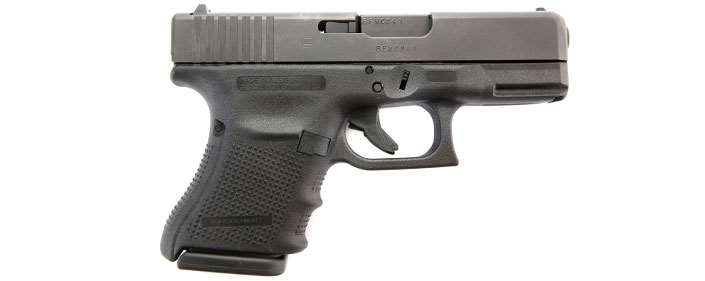
The Carry Gun—Glock 29 Gen4
From the beginning, the 10 mm Auto was considered a self-defense round that would be used in carry pistols. Dornaus & Dixon developed a smaller “Pocket Model” of the Bren Ten, a single-stack, subcompact pistol which never made it beyond the prototype stage. It would be another decade before the concept was revisited. In 1990 Glock jumped into the 10 mm Auto market with its G20, a full-size pistol that matched the 15-round capacity of the “Wonder Nines.” The Glock 20 has survived to be the oldest 10 mm in continuous production. Seven years later, during the pocket-pistol craze of the ’90s, Glock introduced its subcompact G29. Ironically, the overall dimensions of the Glock 29 are strikingly similar to those of the proposed Bren Ten Pocket Model. The G29 is a Glock “pocket rocket” in the truest sense. In the midst of the 1994 crime bill, the 29’s magazine held the maximum allowed capacity of 10 rounds. If you could only have 10, they might as well be 10 mm Autos.
In another 10 years, the rest of the market caught up. Today, the 10 mm is available in a variety of carry packages. The smallest is the Bond Arms Defender, a two-shot, over-under, Remington-style derringer that weighs in at 20 ozs. and is 5.5" overall. EAA offers its Witness line in a compact size, with abbreviated barrel and grip in both steel and polymer frames. Rock Island makes “Commander”-size 1911 models with 4.25". barrels. But for the 10 mm that does the best job of combining compactness with capacity, the Glock 29 still rules the roost.
Though considered a “subcompact” model, the Glock 29 comes closer in size to the company’s “compact” models, like the ubiquitous Glock 19. As a large-frame Glock, the G29 can be a bit much for those with small hands. To remedy this the pistol is currently offered in both Generation 3 “short frame” (SF) and Generation 4 (interchangeable backstrap) configurations. The SF model has a reach of about 2.8" from backstrap to trigger. On the Gen4 model I tested, the interchangeable backstraps changed this length from 2.9" to 3.1". Despite the G29’s compact size, its polymer frame, low bore axis and heavy slide make the recoil of the 10 mm Auto surprisingly easy to manage.
The Glock 29 carries easily for those who are used to toting a mid-sized handgun around. It weighs exactly 2 lbs. with a full magazine of 10 mm Buffalo Bore 155-gr. JHPs. During the months of my 10 mm Auto tests, it spent most of its time stashed inside my waistband in a CrossBreed SuperTuck holster. With that setup, the G29 was comfortable for all-day carry.
Though some may consider the 10 mm Auto overkill for carry, there are plenty of options for those who disagree.
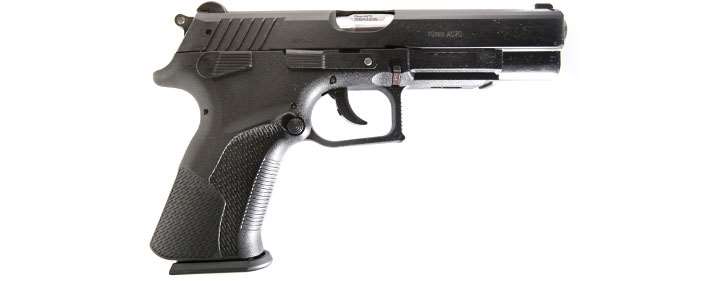
The Double-Action Service Pistol—Grand Power P40L
When the 10 mm Auto was introduced, the platform where it made its debut was the DA/SA semi-automatic service pistol, starting out in the Bren Ten and revived in the FBI’s S&W 1076. The DA/SA platform has seen some of the most interesting 10 mm offerings, from Colt’s short-lived Double Eagle to the Star Megastar, a 52-oz. Spanish-made behemoth.
While the popularity of double-action semi-automatic pistols is waning, you can still get a double-action 10 mm, including variants of SIG’s P220 and EAA’s Witness. A newcomer to the double-action 10 mm field hails from Slovakia; Grand Power offers its P40 model in the chambering. The Grand Power is unique in that it is the only 10 mm ever offered that locks with a rotating barrel. A design that is as old as semi-automatic pistols themselves (the first widely distributed rotary-barrel pistol was the 1907 Roth-Steyr), the system has been used more recently in the Beretta Cougar and PX4 Storm series of handguns.
In the polymer-frame Grand Power, a spiral notch in the bottom of the barrel works against a camming surface in the frame to rotate the barrel clockwise around its bore axis. When the pistol is fired, the locked barrel and slide recoil together. As the barrel rotates, its Browning-style locking lug is disengaged from the slide, unlocking the pistol. Unique among the pistols I tested, the P40 has a feed ramp integral to the frame, meaning the chamber is fully supported.
The P40’s action has a unique safety/decocker mechanism that allows it to be carried Condition One “cocked and locked,” decocked for a traditional DA/SA operation (double-action on the first shot and single-action on subsequent shots) or in double-action-only mode.
Unlike other models from Grand Power, the P40 does not have interchangeable backstraps. Utilizing what it calls the “Universal Ergonomic Grip” the P40’s grip size belies the fact that it’s concealing a double-stack 14-round magazine. The width of the grip and the length of pull in single-action mode is the about the same as the Delta Elite. The Grand Power’s controls are fully bilateral, with a decocker/safety, slide release and magazine release mirrored on each side. The standard P40 has a 4.25" barrel, the same length as the FBI’s S&W 1076. I tested the L (long slide) model with a 5" barrel.
The double-action autoloader is a heritage platform for the 10 mm, and for those who prefer it, there are more viable options available today than ever before.
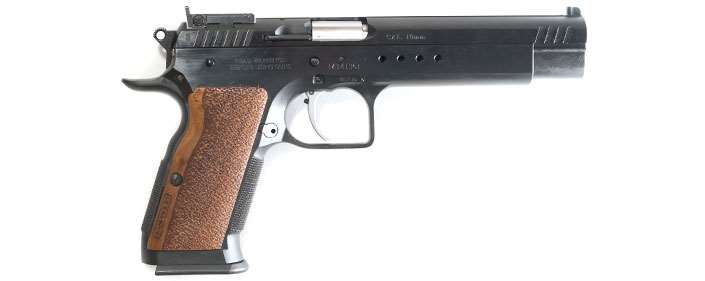
The Hunter—EAA Witness Hunter
With ballistic performance between the .357 Mag. and .41 Mag. revolver cartridges, the 10 mm Auto is a flat-shooting cartridge that is powerful enough for hunting. By 1990, manufacturers were starting to make long-barreled pistols to give hunters the maximum performance out of the 10 mm Auto, with guns such as the 7"-barreled IAI/AMT Javelina and the Wyoming Arms Parker. Today, most of the 10 mms aimed toward the hunting market are based on the M1911, usually long-slide models with 6" barrels to satisfy pistol hunting requirements in some states.
Three hunting 10 mms stand out from the M1911 crowd. Glock makes its model G40, a 6"-barreled pistol with its Miniature Optics System (MOS) for mounting electronic sights to its slide. SIG Sauer offers a Hunter model of its P220, with a single-action trigger, 5" barrel and snake-skin camouflage finish. And EAA has a Hunter model in its Witness line.
The Witness carries on the Bren Ten heritage, with its CZ 75-inspired aesthetics and mechanics. EAA offers an extensive line of 10 mm Auto firearms, with 16 distinct models, from a polymer-frame compact to the top-of-the-line Match Extreme.
The Witness Hunter combines a single-action trigger system from the Witness Match with a 6" barrel. It has many extra features over a base-model Witness, including a fully adjustable rear sight with fiber-optic front, extended controls, factory-tuned trigger with take-up and over-travel adjustment, 20 l.p.i. checkering on the front and back of the grip frame, and an extended and beveled magazine well. The Hunter’s dustcover is extended and, unlike the other pistols represented here, does not feature a rail. But unique among hunting 10 mms, its receiver is drilled and tapped for a scope mount. This means that optics mount solidly to the frame instead of the slide.
For both accuracy testing and hunting I fitted the EAA with a Weaver Classic 2.5-8X 28 mm handgun scope mounted on EAA’s factory mount. This setup, combined with HSM’s Pro Pistol Hunter load—with its 180-gr. Sierra Sports Master JHP averaging around 1100 f.p.s. from the Hunter’s 6" barrel—proved successful on western Virginia whitetail. At a range of just under 50 yds. the Sierra bullet broke ribs on both sides of the buck before lodging under the hide. The deer was recovered about 50 yds. from where it was shot.
By combining the capacity and familiarity of a semi-automatic handgun with a cartridge that is effective on mid-sized game from hogs to whitetails, 10 mm firearms are a viable choice for handgun hunters.

The Carbine—Kriss Vector CRB
Popular pistol calibers always get adapted to companion carbines, and the 10 mm Auto is no exception. When the FBI adopted the 10 mm cartridge, the agency decided it also needed a submachine gun in the same chambering. Heckler and Koch responded with an MP5 in 10 mm exclusively for the American market. For the rest of us who can only dream of a 6-lb., 30", 10 mm Auto submachine gun with burst-fire capability, we have to settle for a semi-automatic 10 mm Auto rifle.
Rifle designs chambered in 10 mm Auto have, historically, been limited. The early D-Max carbine and Auto Ordnance 1927A1 didn’t last long. Starting in the early 1990s, Olympic Arms offered a 10 mm AR-15, either as a complete rifle or as a conversion that allows for the use of a standard AR lower.
In recent years the popularity of pistol-caliber carbines has combined with the rising tide of the 10 mm to result in many new rifles chambered for the cartridge. There are now several 10 mm AR-15s, most of which use the ubiquitous Glock 20 magazine, along with non-AR designs including the TNW Aero Survival, the Just Right Carbine and the recently introduced Hi-Point 10 mm.
The Kriss Vector CRB stands out as one of the most interesting 10 mm carbines currently offered, with its Super V delayed-blowback system of operation. That, combined with the CRB’s inline design and low bore axis, makes for controllable shooting.
My test CRB was the newest Gen II format featuring an M4-style telescoping buttstock and updated trigger and safety lever. Like other Kriss firearms, the 10 mm CRB utilizes Glock magazines.
The Kriss comes with folding back-up sights and rail space on top for optics as well as a fore-end accessory rail. The entire package weights just over 8 lbs. and is 38" overall with the stock fully extended.
The 10 mm Auto cartridge shot out of a 16" barrel makes for formidable performance for a pistol cartridge. The heaviest load I tested in the Kriss was Doubletap’s 180-gr. JHP, which yielded nearly 1500 f.p.s. and 900 ft.-lbs. of energy at the muzzle of the CRB’s rifle-length barrel. A combination like that makes a 10 mm pistol-caliber carbine a viable hunting platform.
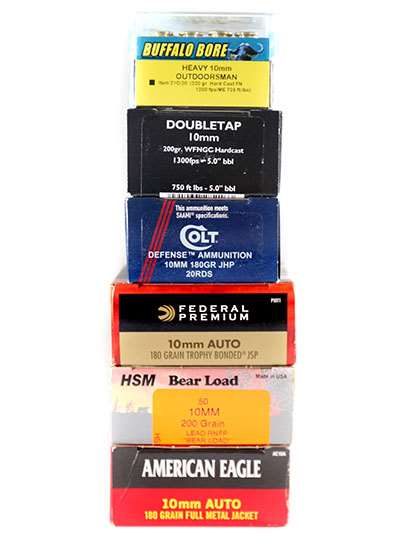
The Ammunition
The story of the revolution in popularity of the 10 mm is not complete without a discussion of ammunition. It used to be that 10 mm Auto shooters were forced to choose from a limited variety of overpriced factory loadings or invest in the equipment to load their own. Today the diversity in 10 mm firearms has been matched by a wide offering of factory ammunition. Twenty-four manufacturers offer nearly 100 unique 10 mm Auto loadings, from Glaser Safety Slugs to heavy, hard-cast bullets. All major American manufacturers offer 10 mm loads, along with imported ammunition from companies such as Armscor and Prvi Partizan. Such proliferation also means that 10 mm ammunition has gotten more affordable, with shooters expecting to pay only a slight premium compared to .40 S&W or .45 ACP ammunition. In the course of testing five different firearms, I personally sampled 20 different loads.
No matter the need, from plinking to self-protection to hunting, the 10 mm shooter can now find a factory load. There are plenty of premium and specialty self-defense 10 mm Auto ammunition options. One unique offering is Doubletap’s Equalizer, a duplex load that combines a 135-gr. JHP on top of a 55-gr. gas-checked lead wadcutter. At 10 yds. out of the Glock 29, the two projectiles averaged an inch spread from each shot. Five shots—10 holes.
The handgun hunter has off-the-shelf ammunition options, too. I tested four factory 10 mm hunting loads, in a variety of bullet types and weights, from HSM, Federal, Doubletap and Buffalo Bore in the EAA Witness Hunter. They also represented a range of velocities and energy levels.
Today’s 10 mm Auto ammunition comes in a range of performance, from “FBI Lite” velocity up to the original full-house Norma spec. Companies such as Buffalo Bore offer two categories of 10 mm loads. Its “Low Flash, Low Recoil” line puts the 10 mm at just above .40 S&W ballistics, while its full-power “Heavy” loadings give maximum performance. Such variety means that without handloading a shooter has the option to use lower-power loads for practice or self-defense with the option of higher-velocity rounds when more performance is needed. While all of this ammunition is loaded to SAAMI specs, proceed with caution and follow the manufacturer’s recommendations as to what type of ammunition is right for your firearm.
To deal with the wide variation in 10 mm ammunition performance adjusting your firearm’s recoil spring may be in order. While most factory springs will handle all 10 mm ammunition, a stiffer spring will prevent wear and tear from a steady diet of heavy loads. Wolff Gunsprings sells “recalibration kits” that provide the shooter with an assortment of spring rates that allow them to tailor their handgun’s function to a specific load they are using. While Wolff makes kits for the Delta Elite and Glock I tested, I only tried their springs in the Witness Hunter, to compensate for the heavy hunting loads I used in it.
The bottom line is that, given the current ammunition market, anyone interested in adding a 10 mm Auto to his or her stable of firearms will not find feeding it to be a problem. (For more details on the 10 mm firearms and ammunition I tested, including tables displaying their performance in the various barrel lengths.
Conclusion
The 10 mm Auto did not take over the military and law enforcement markets as its designers hoped it would, and, through the years, the cartridge has struggled to survive. Now, nearing the end of the second decade of the 21st century, it seems to have found its place. Those looking for magnum performance in a hip-holster-size semi-automatic handgun need look no further. With a new mantle of firearms and loads, the 10 mm Auto is garnering widespread acceptance. Long the choice of die-hard fans, for the first time in the nearly four decades of its existence, it can finally be said with certainty that the Ten is here to stay.
The author would like to thank the following, whose insight and experience contributed to this article: Michael Dixon, John C. Hall, Tracie Hill, Bob Lippman, Bill Vanderpool, the soldiers of the Danish military and the agents of the FBI’s Firearms Training Unit.
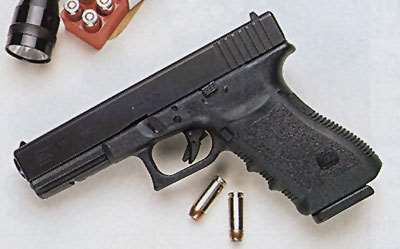
Loaded For Bear—And Musk Ox: 10 mm Glocks Of The Danish Sirius Dog Sled Patrol
If you were expecting to encounter the largest land carnivore in the world, what would your sidearm of choice be? For members of Denmark’s Sirius Dog Sled Patrol the answer is the 10 mm Glock 20. Greenland is a country within the Kingdom of Denmark, and the Danish military is responsible for providing for its defense. The Sirius Patrol (their name in Danish is “Slædepatruljen Sirius”) is a unit of the Danish navy that operates in the uninhabited area of northeast Greenland. Originating from a group of volunteers formed during World War II that fought off German incursions into Greenland, the modern Sirius Patrol asserts Danish sovereignty along nearly 9,000 miles of coastline.
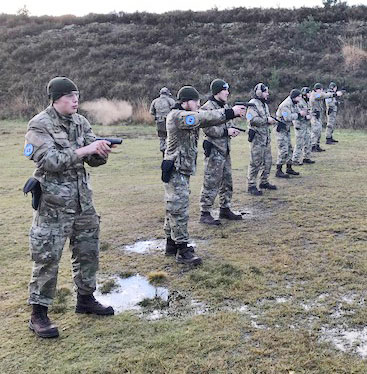 Arctic Greenland is one of the most physically demanding environments in the world, with 24-hour darkness and temperatures that reach 50° F below zero in the winter. Those dangers also include the native wildlife. The two largest animals in Greenland, the musk ox and the polar bear, are often encountered by the Sirius patrollers. The polar bear is an alpha predator whose adult males can reach a length of 10 ft. and weigh up to 1,500 lbs. The musk ox is about half the weight of an American bison, but its head is capped with a pair of Cape buffalo-like horns.
Arctic Greenland is one of the most physically demanding environments in the world, with 24-hour darkness and temperatures that reach 50° F below zero in the winter. Those dangers also include the native wildlife. The two largest animals in Greenland, the musk ox and the polar bear, are often encountered by the Sirius patrollers. The polar bear is an alpha predator whose adult males can reach a length of 10 ft. and weigh up to 1,500 lbs. The musk ox is about half the weight of an American bison, but its head is capped with a pair of Cape buffalo-like horns.
The Glock 20 was adopted by the Sirius Patrol around 2000 as a replacement for the 9 mm Luger m/49, the Danish designation for the country’s SIG P210 service pistol, after it experienced problems using the 9 mm Luger cartridge against large mammals. Although 10 mm Auto is not a common chambering in Europe, ammunition is sourced from Serbian manufacturer Prvi Partizan. Issued ammunition features a jacketed flat-point bullet.
The Glock 20 is paired with another gun unique for a 21st century elite military force. The rifle the Sirius Patrol carries is the century-old Pattern 1917 Enfield, known in Danish service as the Gevær M/53 (17), in .30-’06 Sprg. These rifles, along with M1 Garands, were sent to Denmark as part of NATO Cold War armament cooperation. The rugged bolt-action guarantees function in Artic conditions, and the .30-’06 Sprg. cartridge is more powerful than the 5.56x45 mm NATO Karabin M/96 (a version of the Canadian C8 M16 variant) that Danish forces currently issue. Sirius members carry their Glock 20s constantly, in a Safariland Universal Military holster and attached to the belt by lanyard. It is always on their side when operating at their Daneborg headquarters and is the backup to their Enfield rifles while on patrol. As an arm of last resort, the 10 mm Glock has proved successful in several close-range encounters with both polar bear and musk ox, most involving multiple rounds fired rapidly at extremely close range.
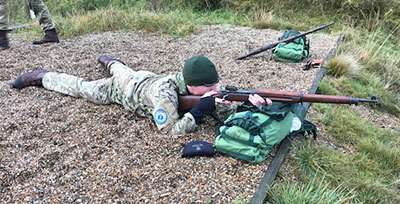
New Sirius recruits are given 28 hours of basic pistol training, followed by CQB and night-shooting courses in which they will fire a total of 3,000 to 4,000 rounds. The only complaint the Sirius patrol has with its Glock pistols is adapting to its trigger after using the “match-grade” single-action P210.
Since the adoption of the Glock, the Danish military has considered alternatives, including .357 Mag. and .44 Mag. revolvers that were tested by firing them into ballistic gelatin covered in polar bear hide. The result was that the capacity and shootability of the 10 mm Glock won out over the revolvers—the Danes have discovered what many in the civilian world also know. For magnum performance from a service-size, semi-automatic handgun, the 10 mm is hard to beat.
Additional Reading:
Full Power/Full Auto: The Thompson Goes Metric and the MP5 Goes American
Field Notes: 10 mm Auto













